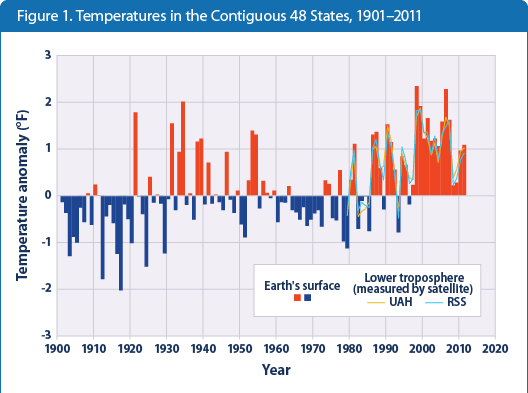Climate Change
Climate Change Indicators in the United States

This figure shows how annual average temperatures in the contiguous 48 states have changed since 1901. Surface data come from land-based weather stations. Satellite measurements cover the lower troposphere, which is the lowest level of the Earth's atmosphere. "UAH" and "RSS" represent two different methods of analyzing the original satellite measurements. This graph uses the 1901 to 2000 average as a baseline for depicting change. Choosing a different baseline period would not change the shape of the data over time.
Data source: NOAA, 2012 1

This figure shows how annual average temperatures worldwide have changed since 1901. Surface data come from a combined set of land-based weather stations and sea surface temperature measurements. Satellite measurements cover the lower troposphere, which is the lowest level of the Earth's atmosphere. "UAH" and "RSS" represent two different methods of analyzing the original satellite measurements. This graph uses the 1901 to 2000 average as a baseline for depicting change. Choosing a different baseline period would not change the shape of the data over time.
Data source: NOAA, 2012 2

This figure shows how annual average air temperatures have changed in different parts of the United States since the early 20th century (since 1901 for the contiguous 48 states, 1905 for Hawaii, and 1918 for Alaska).
Data source: NOAA, 2012 3
Key Points
- Since 1901, the average surface temperature across the contiguous 48 states has risen at an average rate of 0.13°F per decade (1.3°F per century) (see Figure 1). Average temperatures have risen more quickly since the late 1970s (0.31 to 0.45°F per decade). Seven of the top 10 warmest years on record for the contiguous 48 states have occurred since 1990.
- Worldwide, 2001-2010 was the warmest decade on record since thermometer-based observations began. Global average surface temperature has risen at an average rate of 0.14°F per decade since 1901 (see Figure 2), similar to the rate of warming within the contiguous 48 states. Since the late 1970s, however, the United States has warmed faster than the global rate.
- Some parts of the United States have experienced more warming than others (see Figure 3). The North, the West, and Alaska have seen temperatures increase the most, while some parts of the Southeast have experienced little change. However, not all of these regional trends are statistically significant.
Background
Temperature is a fundamental measurement for describing the climate, and the temperature in particular places can have wide-ranging effects on human life and ecosystems. For example, increases in air temperature can lead to more intense heat waves, which can cause illness and death, especially in vulnerable populations. Annual and seasonal temperature patterns also determine the types of animals and plants that can survive in particular locations. Changes in temperature can disrupt a wide range of natural processes, particularly if these changes occur more quickly than plant and animal species can adapt.
Concentrations of heat-trapping greenhouse gases are increasing in the Earth's atmosphere (see the Atmospheric Concentrations of Greenhouse Gases indicator). In response, average temperatures at the Earth's surface are rising and are expected to continue rising. However, because climate change can shift the wind patterns and ocean currents that drive the world's climate system, some areas experience more warming than others, and some might experience cooling.
About the Indicator
This indicator examines U.S. and global surface temperature patterns from 1901 to the present. U.S. surface measurements come from weather stations on land, while global surface measurements also incorporate observations from buoys and ships on the ocean, thereby providing data from sites spanning much of the surface of the Earth. For comparison, this indicator also displays satellite measurements that can be used to estimate the temperature of the Earth's lower atmosphere since 1979.
This indicator shows anomalies, which compare recorded annual temperature values against a long-term average. For example, an anomaly of +2.0 degrees means the average temperature was 2 degrees higher than the long-term average. This indicator uses the average temperature from 1901 to 2000 as a baseline for comparison. Annual anomalies are calculated for each weather station, starting from daily and monthly average temperatures. Anomalies for broader regions have been determined by dividing the country (or the world) into a grid, averaging the data for all weather stations within each cell of the grid, and then averaging the grid cells together (for Figures 1 and 2) or displaying them on a map (Figure 3). This method ensures that the results are not biased toward regions that happen to have many stations close together.
Indicator Notes
Data from the early 20th century are somewhat less precise than more recent data because there were fewer stations collecting measurements at the time, especially in the Southern Hemisphere. However, the overall trends are still reliable. Where possible, the data have been adjusted to account for any biases that might be introduced by station moves, development (e.g., urbanization) near the station, changes in instruments and times of measurement, and other changes.
Data Sources
The data for this indicator were provided by the National Oceanic and Atmospheric Administration's National Climatic Data Center, which maintains a large collection of climate data online at: www.ncdc.noaa.gov/oa/
ncdc.html. Surface temperature anomalies were calculated based on monthly values from a network of long-term monitoring stations. Satellite data were analyzed by two independent groups—the Global Hydrology and Climate Center at the University of Alabama in Huntsville (UAH) and Remote Sensing Systems (RSS)—resulting in slightly different trend lines.
Technical Documentation
- Download related technical information PDF (9 pp, 152K, About PDF)





